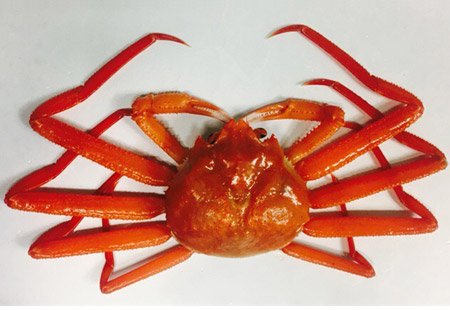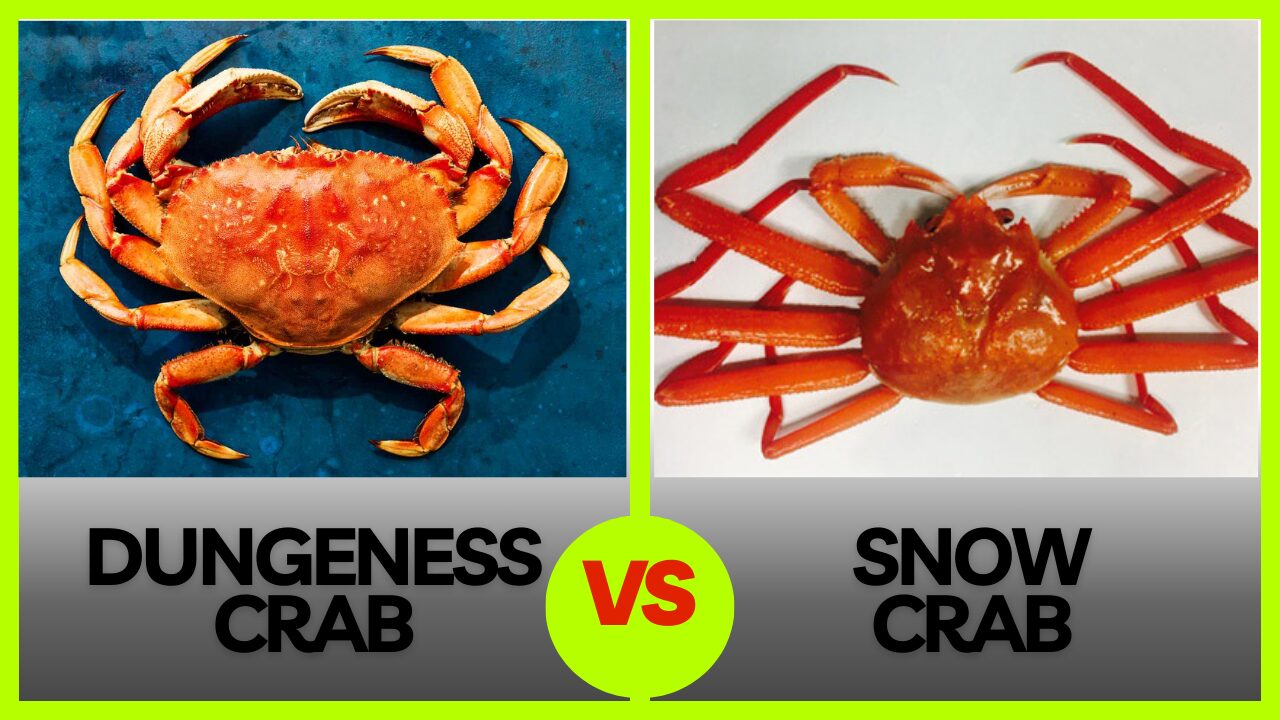Where else in nature can you find a creature that wears its skeleton on the outside? or famous for their funky sideways walk? Yes its Crab always! Bizarreness Doesn’t end here. You have to give credit to crabs for turning their 2 out of 10 legs into built-in hammers, scissors, and dinner forks. Whether it’s for smashing, snipping, ripping, or bringing food to their mouths, crab claws are the ultimate multi-tool. Beyond their quirky funny appearance, we humans love crabs for their delicious meat! Whether you’re a beach enthusiast, a seafood lover, or just someone who appreciates the wonders of nature, crabs never fail to bring a sense of excitement to the table.
Dungeness Vs Snow Crab: Comparisons
For seafood lovers, few things beat the sweet, Salty taste of fresh crab. On the West Coast, the nutty Dungeness crab rules supreme as the regional specialty, especially during the winter holidays. But on the opposite end of the continent, sweet snow crab draws its own devoted fans, particularly in Canada and the northern United States. Dungeness and snow crab each have their own merits . but which one reigns supreme? Let’s take a closer look at how these two crabs take a lead across various categories:
Dungeness Vs Snow Crab: Appearance
Winner- Dungeness Crab

- Dungeness Crab: (Metacarcinus magister)
- As the name suggest, are known for their larger size. On average, they have a oval-shaped shell reaching up to 10 inches across and can weigh up to 2 Kgs or more.
- They have robust bodies and impressive claws. The shell is yellow-brownish and patterned with purple spots.
- Dungeness crab has a triangular-oval-shaped body and four pairs of walking legs and a pair of claws.
- The claws have light-colored tips, sharp saw-edged teeth and a pronounced hook at the tips to dig out its food.

- Snow Crab: (Chionoecetes opilio)
- Snow crabs are spider-like in shape, with a flat, round shell and long, slender legs.
- They have a more angular and oval-shaped shell. They have a dark brown top shell contrasted by pale legs and claws.
- Snow crabs can grow to a maximum shell width of about 7 inches across, with males growing more than twice as large as females (females are not harvested commercially for this reason).
- The narrower body and skinnier legs of snow crab give it a leggier look compared to the thicker Dungeness.
Dungeness Vs Snow Crab: Lifespan
Winner- Snow Crab
- Dungeness Crab:
- Dungeness crabs live up to 8-10 years in the wild.
- They start off as larvae drifting in the ocean before settling to the seafloor as juveniles after 4-5 months.
- It takes about 2-3 years for Dungeness crabs to reach harvest size and full maturity to reproduce.
- The large, meaty crabs are caught commercially at around 5-7 years of age. T
- heir lifespan is impacted by natural predators and fishing pressure.

- Snow Crab:
- Snow crabs live 15-20 years in their cold water habitats.
- The early larval stages develop more slowly compared to Dungeness crabs, with snow crabs settling to the seafloor after 1-2 years as juveniles.
- It takes around 4 years for snow crabs to reach maturity and be ready for mating.
- Commercially harvested snow crabs are generally 7-10 years old.
- Their frigid environments and lower fishing pressure allow snow crabs to live longer than the quicker growing Dungeness.
Dungeness Vs Snow Crab: Meat & Flavor
Winner- Dungeness Crab

- Dungeness Crab:
- Dungeness crab meat is sweet, succulent, and delicate. The flesh is moist and tender with a flaky texture similar to lobster
- It has a slightly fibrous texture that holds up well in various culinary preparations. The meat comes in thick, chunky flakes, making it satisfying to bite into.
- A good amount of meat found in the legs, body, and claws, within each section. Around 1⁄4 of the crab’s weight is meat.
- When it comes to taste, Dungeness crab meat has a sweet nutty flavor with mild Saltiness and delicate sweetness.
- It has been described as having notes of butter or seaweed.

- Snow Crab:
- Snow crab meat is delicate and soft. It bit more stringy and can have a grainy texture.
- The meat is delicate, flaky, and has a firmer texture. Snow crab legs are popular for their long, slender sections of meat.
- When it comes to taste, It is known for its subtle and mild taste with a touch of saltiness.
- Snow crab meat is also sweet, but it tends to have a milder flavor compared to Dungeness crab
- Some find it blander than Dungeness crab.
Ultimately flavor preference is subjective, but Dungeness crab gets points for easier access to its tasty meat.
Dungeness Vs Snow Crab: Nutritional Value
Winner- Dungeness Crab
- Dungeness crab:
- According to Alaska Dept. of Fish and Game-Dungeness crab has a health advantage. A 3 oz serving of Dungeness crab contains 90 calories, 20 grams of protein, 1 gram of fat, and 20% of the Daily Value of selenium.
- Selenium helps support immunity and thyroid function.
- Dungeness crab delivers more protein per calorie along with the selenium bonus.
- They are low in fat and high in calories but rich in omega-3 fatty acids, vitamin B12, and zinc.
- They also provide minerals like copper and phosphorus.
- Snow crab:
- According to US dept of Agriculture– Snow crab has 84 calories, 19 grams of protein and 0.7 grams of fat in a 3 oz portion, along with some B vitamins, but does not contain the same selenium levels.
- Snow crabs are also nutritious and offer a good amount of protein, omega-3 fatty acids, vitamin B12, and minerals such as zinc and selenium.
- They are relatively low in fat and calories.
- Nutrients found in snow crabs are vital for brain health, bone strength, and metabolic functions.
Due to high protein and low fat with lots of Nutrients Value+ selenium, Dungeness takes lead here.
Dungeness vs Snow Crab: Availability
Winner- Dungeness Crab
- Dungeness Crab:
- Dungeness crab is primarily found along the west coast of North America, ranging from Alaska to California.
- It is a popular seafood item in the United States, particularly in the Pacific Northwest.
- Dungeness crab is harvested commercially and recreationally in these areas only.
- Dungeness crab fishing is highly regulated and limited to a short winter season on the Pacific coast from California up to Alaska.
- Due to the controlled fishing season, fresh Dungeness is harder to source outside the northwest.
- Snow Crab:
- For freshness and availability, snow crab has an edge over Dungeness seasonally. It’s readily available fresh or frozen.
- Snow crab has a broader distribution compared to Dungeness crab. It is found in the cold waters of the North Atlantic and North Pacific.
- In the North Atlantic, snow crab is abundant in the waters off the coast of Canada, particularly in the Gulf of St. Lawrence and Newfoundland and Labrador.
- It is also harvested in other countries such as Norway and Russia.
- Snow crab is exported to various countries around the world, including the United States, Japan, and Europe.
Due to the controlled fishing season, fresh Dungeness is harder to source outside the northwest.
Dungeness Vs Snow Crab: Price
Winner- Snow Crab
- Dungeness Crab:
- Dungeness crab is generally considered to be a higher-priced crab compared to Snow crab.
- The price of Dungeness crab can vary based on factors such as size (larger crabs tend to be more expensive), availability, and the region where it is purchased.
- In the United States, Dungeness crab is often considered a delicacy and can command higher prices, particularly in markets along the west coast where it is locally sourced.
- Prices for live Dungeness crab can range from around $7 to $15 per pound, while cooked and cleaned crab meat can range from $25 to $40 per pound, depending on the location and quality.
- Snow Crab:
- Snow crab is generally considered to be a more affordable crab compared to Dungeness crab.
- The price of Snow crab can vary depending on factors such as size, availability, and the region where it is purchased.
- Snow crab is widely available in North America, particularly in Canada and the United States, where it is harvested in significant quantities.
- Prices for live Snow crab can range from around $6 to $12 per pound, while cooked and cleaned crab meat can range from $18 to $30 per pound, depending on the location and quality.
Note: When purchasing and consuming crab, it is recommended to choose seafood products from sustainable and well-managed sources, look for certifications such as the Marine Stewardship Council (MSC)
Dungeness Vs Snow Crab: Feeding Habits
Winner- Snow Crab
- Dungeness Crab:
- According to California Sea Grant– Dungeness crabs are opportunistic feeders with a diverse diet.
- They are primarily scavengers and predators, feeding on a wide range of prey items found in their habitat.
- Dungeness crabs are known to consume small fish, clams, mussels, barnacles, snails, worms, shrimp, and other marine invertebrates.
- They are known to be omnivorous, consuming both plant matter and animal remains.
- Dungeness crabs use their strong, crushing claws to crack open shells and access their prey.
- Snow Crab:
- According to NOAA– Snow crabs are primarily scavengers and feed on a variety of food sources available in their habitat.
- Their diet includes detritus (dead organic matter), small mollusks, worms, small crabs, and other decaying matter found on the ocean floor.
- Snow crabs have specialized mouthparts called maxillipeds that they use to scrape food particles from the sediment.
- They are not as aggressive predators as Dungeness crabs and rely more on feeding opportunistically on available food sources.
Dungeness Vs Snow Crab: Difficulty of Eating
Winner- Snow Crab
- Dungeness Crab:
- Dungeness crab can be slightly more challenging to eat compared to Snow crab due to its larger size and thicker shell.
- Breaking open the shell of a Dungeness crab requires some strength esp. when dealing with the larger claws.
- The meat of Dungeness crab is found in the body, legs, and claws, and it requires some effort to extract the meat from the shell.
- Snow Crab:
- Snow crab is generally easier to eat compared to Dungeness crab due to its smaller size and more delicate shell.
- The shells of Snow crab are thinner and more brittle, making them easier to crack open.
- The meat of Snow crab is found in the legs and body, and it is usually more readily accessible compared to Dungeness crab.
Dungeness Vs Snow Crab: Conservation Status
Winner- Tie
- Dungeness Crab:
- Dungeness crab populations are generally considered to be stable and not currently at risk.
- Dungeness crab fisheries in the United States are managed by The Pacific States Marine Fisheries Commission (PSMFC)
- Dungeness crab populations are generally well-managed and subject to regular assessments to monitor their health.
- It is essential for fishermen and seafood consumers to adhere to fishing regulations to support the long-term health of the species and its ecosystem.
- Snow Crab:
- The conservation status of Snow crab can vary depending on the region and population.
- In some areas, such as the Gulf of St. Lawrence in Canada, Snow crab populations have faced fluctuations due to factors like environmental changes and fishing pressure.
- Fisheries and Oceans Canada, have implemented measures to promote sustainable Snow crab fisheries, including catch limits, fishing seasons, and gear restrictions.
- These management practices aim to protect Snow crab populations, minimize bycatch, and maintain the overall health of the ecosystem.
Conclusion
And the Winner Is…!!
It would be inappropriate to declare a “winner” between Dungeness Vs Snow Crab as they are different species with their own unique characteristics and qualities. Some individuals may prefer the richness and sweetness of Dungeness crab, while others may enjoy the delicate and mild flavor of Snow crab. Both crabs are highly regarded in the culinary world. Now it’s your turn to decide: based on the attributes we covered. Which crab comes out on top in your book? – the mighty Dungeness crab or the queen Snow crab? Do you agree with the ‘winners’ declared for each category or might you judge differently? Share your thoughts and opinions in the comments below!

